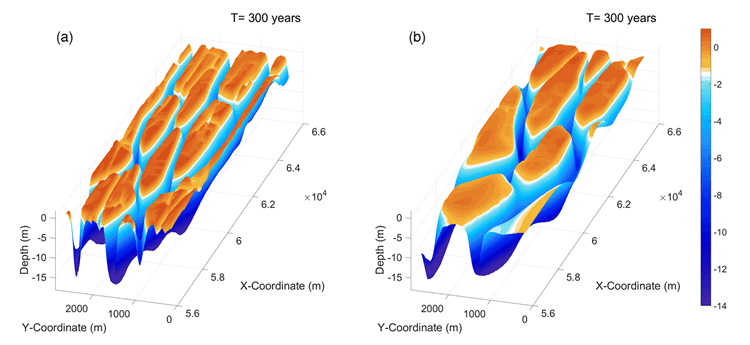H. Elmilady1,2,3*, M. van der Wegen 1,2, D. Roelvink 1,2,3, and A. van der Spek 2
1 IHE Delft,
2 Deltares,
Abstract
Intertidal shoals are key components of the estuarine environment. Ensuring their sustainability requires understanding the potential morphological impact of sea-level rise (SLR) on such systems. In contrast to mudflats, sandy shoals have drawn limited attention in research. Inspired by the channel-shoal systems in the Western Scheldt Estuary and Wadden Sea, our work investigates the mechanisms that drive the long-term morphological evolution of sandy shoals.
We apply a high resolution (35 × 65 m) process-based model (Delft3D) to simulate the evolution of a sandy channel-shoal system in a schematized rectangular (20 × 2.5 km) tidal basin. An initially mildly sloping submerged bathymetry is subjected to constant (M2) semidiurnal tidal forcing along with small wind-generated waves (10-20 cm) modeled by SWAN.
Initial bed-level perturbations trigger a positive morphodynamic feedback between the currents and morphology leading to the emergence of large scale channel-shoal patterns (Figure 1). Shoal formation is driven by tidal currents while wind-waves play an important role when shoals become shallow and intertidal. The added wave-induced shear stress enhances sediment resuspension and redistribution over the shoal along with limiting the shoal elevation. Over a long time-scale (centuries), the residual sediment transport starts diminishing towards a relatively steady morphological state maintained by a balance between sediment supply, wave action, and tidal forcing.
SLR triggers sediment import from the seaward boundary. Shoals accrete due to the drop of wave-induced shear stresses associated with the increased water depth. Highest accretion occurs at the shoal edges and gradually decreases towards central locations. Waves help redistribute the sediment supplied from the channel over the shoal. However, accretion rates are less than the SLR rate leading to intertidal area loss and increased shoal inundation. Incorporating mud fractions accelerates the response to SLR resulting in faster accretion and muddier shoals.

Figure 1 The modelled bathymetry (a) Flow only, and (b) Flow and Waves after 300 years for a section of the model domain. The white band represents the border between intertidal and subtidal areas.
I. Surname1*, F.N. Another-Surname2 , Y. Next-Surname2
1 University Name, Country; 2 Organization Name, Country
* Corresponding author: mail.name@organization.org


